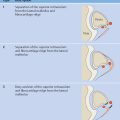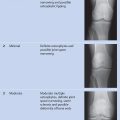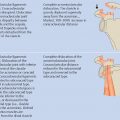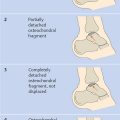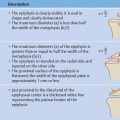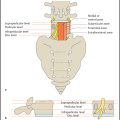Hip(I)
Radiographic Landmarks of the Hip
The following radiographic landmarks and their interrelationships are helpful in diagnosing congenital and acquired abnormalities of the acetabulum ( Fig. 2.1 ):
Iliopectineal line (arcuate line, linea terminalis): The iliopectineal line is the radiographic reference line for the anterior column.
Ilioischial line: The upper portion of this line is formed by the posterior part of the quadrilateral plate, its lower portion by the ischium (medial boundary). The ilioischial line is the landmark for the posterior column.
Acetabular roof line.
Acetabular teardrop: This is a teardrop-shaped figure formed laterally by the medial portion of the acetabulum and medially by the antero-inferior portion of the quadrilateral plate. The quadrilateral plate is the posterior wall of the acetabulum, which faces inward on the pelvic inlet and presents an approximately square, flat surface.
Anterior rim of the acetabulum.
Posterior rim of the acetabulum.
Femoral Neck–Shaft Angle and Anteversion Angle
Projected Neck–Shaft Angle
The projected femoral neck–shaft angle (NSA, called also the caput–collum–diaphyseal (CCD) angle; Fig. 2.2 ) is determined on the anteroposterior (AP) pelvic radiograph or the AP radiograph of the hip and femur. It is the angle formed by the longitudinal axes of the neck and shaft of the femur.
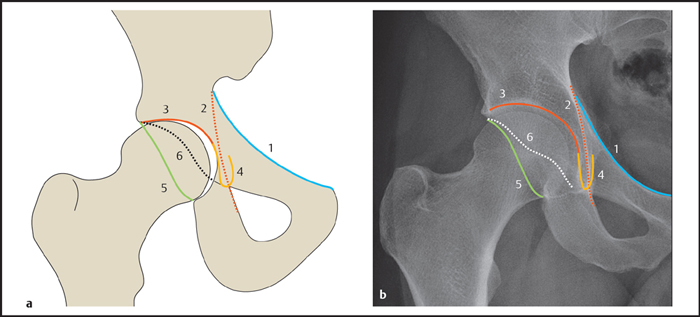
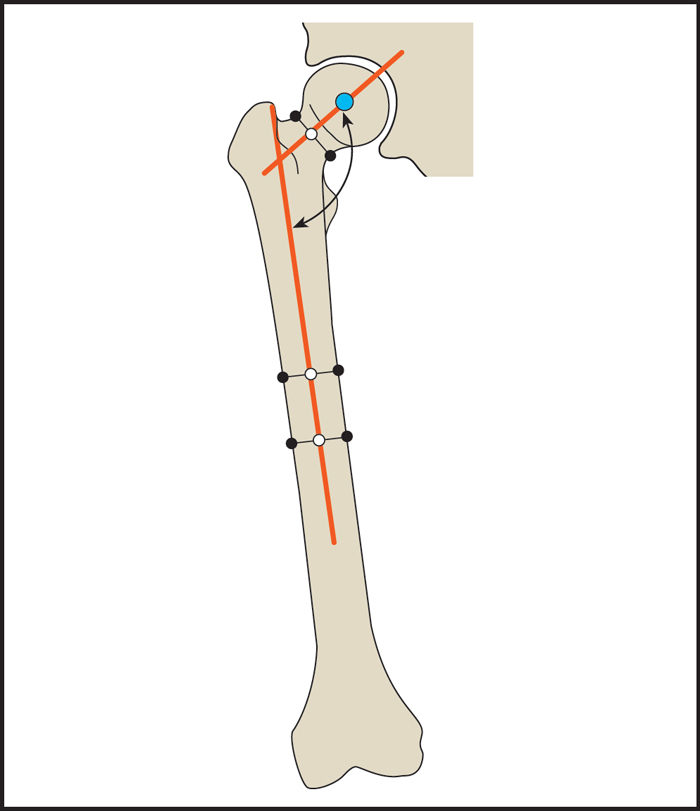
The femoral neck axis can be determined as follows ( Fig. 2.3 ): first the center of the femoral head is located with a circle template or computer-assisted technique at a workstation. Next a line is drawn connecting the points where the circle intersects the medial and lateral borders of the femoral neck. A line drawn perpendicular to that line through the center of the femoral head represents the femoral neck axis.
M.E. Müller uses the following method for an accurate reconstruction of the NSA:
The center of the femoral head is located with a circle template or a computer-assisted technique. Reference points for the circular arc are the lateral portion (outermost point) of the epiphysis and the medial corner of the femoral neck.
The point of deepest concavity on the lateral border of the femoral neck is marked.
Another arc through that point using the center of the femoral head as the center is drawn.
The points where the circle intersects the femoral neck are connected.
A line is drawn perpendicular to that line through the center of the femoral head. That line represents the femoral neck axis.
The femoral shaft axis is drawn midway between the lateral and medial borders of the femoral shaft.
Projected NSA
• Normal values in adults: | ~ 120–130° |
• Coxa valga: | > 130° |
• Coxa vara: | < 120° |
The anteversion of the proximal femur causes the NSA to appear larger on radiographs than it really is.

M = Center of the femoral head
A = Point where the circle intersects the lateral cortex of the femoral neck
B = Point where the circle intersects the medial cortex of the femoral neck
1 = Femoral neck axis (line perpendicular to AB through M)
b M. E. Müller method for accurate reconstruction of the femoral neck axis.
M = Center of the femoral head
A = Deepest point in lateral concavity of the femoral neck
B = Point on medial border of the femoral neck defined by the second arc
1 = Femoral neck axis (line perpendicular to AB through M)
2 = Femoral shaft axis
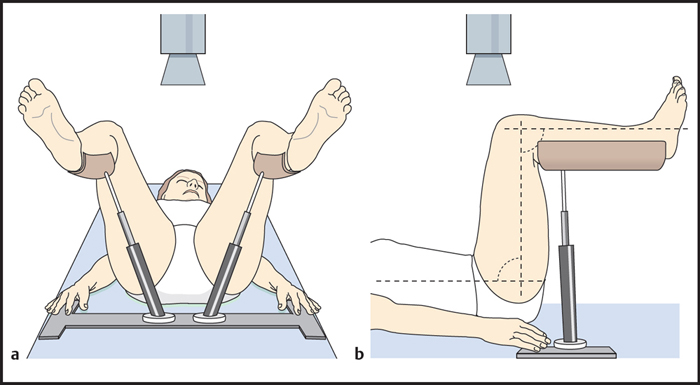
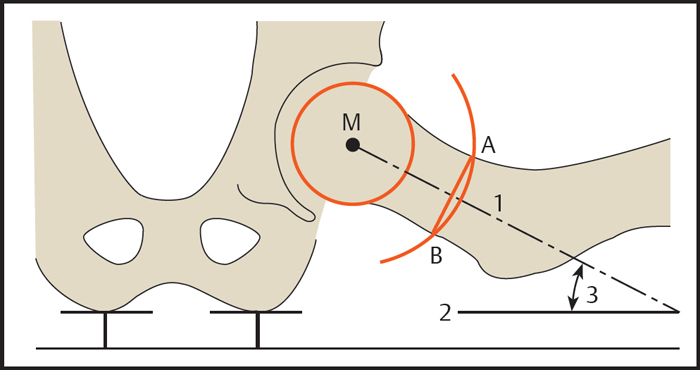
1 = Femoral neck axis (line perpendicular to AB through M)
2 = Horizontal plane (defined by the positioning frame)
3 = Projected anteversion angle
Müller ME. Die hüftnahen Femurosteotomien. 1st ed. Stuttgart: Thieme; 1957Projected Anteversion Angle (Dunn–Rippstein–Müller Method)
Today the Dunn–Rippstein–Müller method is widely used to assess rotational deformity by calculating the true NSA and femoral anteversion (AV) angle. The projected AV angle is measured on a radiograph in the Rippstein projection (called also the Rippstein II view). This projection is standardized by using a positioning frame that holds the hip in 90° of flexion and 20° of abduction ( Fig. 2.4 ).
The AV angle is measured between the horizontal plane (defined by the positioning frame) and the femoral neck axis ( Fig. 2.5 ). The Müller method (see p. 11) is best for determining the femoral neck axis. When calculated in this way, the AV angle is determined relative to the transverse axis of the femoral condyles.
True Neck–Shaft Angle and Anteversion Angle
Geometric formulae are available for converting the projected NSA and AV angle to the true angles.
Calculation of the true AV angle:

Calculation of the true NSA:
cot β = cot β2 • cot α
where:
α = true AV angle
α2 = projected AV angle
β2 = projected NSA
γ = abduction angle of the femur = 20°
The use of conversion charts will facilitate the rapid calculation of values in everyday practice. The chart published by Müller in 1957 is a well-established clinical tool ( Table 2.1 ). Another current option is the use of computer software.
Both the NSA and AV angle change with aging and show a large range of variation. Tables 2.2 and 2.3 list age-adjusted normal values and analytic criteria proposed by the Commission for the Study of Developmental Dysplasia of the Hip of the German Society for Orthopedics and Traumatology. These tables can be helpful in routine clinical decision-making. Prognostic assessments are difficult, however, because spontaneous normalization often occurs during growth and cannot be predicted with certainty.
Dunn DM. Anteversion of the neck of the femur; a method of measurement. J Bone Joint Surg Br 1952;34-B (2):181–186 Müller ME. Die hüftnahen Femurosteotomien. 1st ed. Stuttgart: Thieme; 1957 Rippstein J. Determination of the antetorsion of the femur neck by means of two x-ray pictures. [Article in German] Z Orthop Ihre Grenzgeb 1955;86(3):345–360 Tönnis D. Die angeborene Hüftdysplasie und Hüftluxation im Kindes- und Erwachsenenalter. Chapter 9: Allgemeine Röntgendiagnostik des Hüftgelenks. Berlin: Springer; 1984; 129–134
Stay updated, free articles. Join our Telegram channel

Full access? Get Clinical Tree



